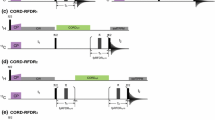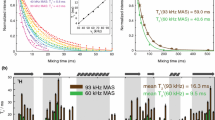Abstract
A recently developed homonuclear dipolar recoupling scheme, Adiabatic Linearly FREquency Swept reCOupling (AL FRESCO), was applied to record two-dimensional (2D) 15N–15N correlations on uniformly 15N-labeled GB1 powders. A major feature exploited in these 15N–15N correlations was AL FRESCO’s remarkably low RF power demands, which enabled seconds-long mixing schemes when establishing direct correlations. These 15N–15N mixing schemes proved efficient regardless of the magic-angle spinning (MAS) rate and, being nearly free from dipolar truncation effects, they enabled the detection of long-range, weak dipolar couplings, even in the presence of strong short-range dipolar couplings. This led to a connectivity information that was significantly better than that obtained with spontaneously proton-driven, 15N spin-diffusion experiments. An indirect approach producing long-range 15N–15N correlations was also tested, relying on short (ms-long) 1HN–1HN mixings schemes while applying AL FRESCO chirped pulses along the 15N channel. These indirect mixing schemes produced numerous long-distance Ni–Ni±n (n = 2 − 5) correlations, that might be useful for characterizing three-dimensional arrangements in proteins. Once again, these AL FRESCO mediated experiments proved more informative than variants based on spin-diffusion-based 1HN–1HN counterparts.




Similar content being viewed by others
References
Aluas M, Tripon C, Griffin JM, Filip X, Ladizhansky V, Griffin RG, Brown SP, Filip C (2009) CHHC and 1H–1H magnetization exchange: analysis by experimental solid-state NMR and 11-spin density-matrix simulations. J Magn Reson 199:173–187
Baldus M, Petkova AT, Herzfeld J, Griffin RG (1998) Cross polarization in the tilted frame: assignment and spectral simplification in heteronuclear spin systems. Mol Phys 95:1197–1207
Baum J, Tycko R, Pines A (1985) Broadband and adiabatic inversion of a two-level system by phase-modulated pulses. Phys Rev A 32:3435–3447
Bayro MJ, Huber M, Ramachandran R, Davenport TC, Meier BH, Ernst M, Griffin RG (2009) Dipolar truncation in magic-angle spinning NMR recoupling experiments. J Chem Phys 130:114506
Bennett AE, Ok JH, Griffin RG, Vega S (1992) Chemical shift correlation spectroscopy in rotating solids: radio frequency-driven dipolar recoupling and longitudinal exchange. J Chem Phys 96:8624–8627
Brinkmann A, Levitt MH (2001) Symmetry principles in the nuclear magnetic resonance of spinning solids: heteronuclear recoupling by generated Hartmann-Hahn sequences. J Chem Phys 115:357–384
de Boer I, Bosman L, Raap J, Oschkinat H, de Groot HJM (2002) 2D13C-13C MAS NMR correlation spectroscopy with mixing by true 1H spin diffusion reveals long-range intermolecular distance restraints in ultra-high magnetic field. J Magn Reson 157:286–291
De Paëpe G, Lewandowski JR, Loquet A, Böckman A, Griffin RG (2008) Proton assisted recoupling and protein structure determination. J Chem Phys 129:245101
Donovan KJ, Silvers R, Linse S, Griffin RG (2017) 3D MAS NMR experiment utilizing through-space 15N–15N correlations. J Am Chem Soc 139:6518–6521
Franks WT, Zhou DH, Wylie BJ, Money BG, Graesser DT, Frericks HL, Sahota G, Rienstra CM (2005) Magic-angle spinning solid-state NMR spectroscopy of the beta1 immunoglobulin binding domain of protein G (GB1): 15N and 13C chemical shift assignments and conformational analysis. J Am Chem Soc 127:12291–12305
Franks WT, Wylie BJ, Stellfox SA, Rienstra CM (2006) Backbone conformational constraints in a microcrystalline U-15N-labeled protein by 3D dipolar-shift solid-state NMR spectroscopy. J Am Chem Soc 128:3154–3155
Frericks-Schmidt HL, Sperling LJ, Gao YG, Wylie BJ, Boettcher JM, Wilson SR, Rienstra CM (2007) Crystal polymorphism of protein GB1 examined by solid state NMR spectroscopy and X-ray diffraction. J Phys Chem B 111:14362–14369
Fung BM, Khitrin AK, Ermolaev K (2000) An improved broadband decoupling sequence for liquid crystals and solids. J Magn Reson 142:97–101
Garwood M, de la Barre L (2001) The return of the frequency sweep: designing adiabatic pulses for contemporary NMR. J Magn Reson 153:155–177
Giraud N, Blackledge M, Bockmann A, Emsey L (2007) The influence of nitrogen-15 proton-driven spin diffusion on the measurement of nitrogen-15 longitudinal relaxation times. J Magn Reson 184:51–61
Goldbourt A, Day LA, McDermott AE (2007) Assignment of congested NMR spectra: Carbonyl backbone enrichment via the Entner-Doudoroff pathway. J Magn Reson 189:157–165
Grommek A, Meier BH, Ernst M (2006) Distance information from proton-driven spin diffusion under MAS. Chem Phys Lett 427:404–409
Hou G, Sun S, Han Y, Byeon I-J, Ahn J, Concel J, Samoson A, Gronenborn AM, Polenova T (2011) Spin diffusion driven by R-symmetry sequences: applications to homonuclear correlation spectroscopy in MAS NMR of biological and organic solids. J Am Chem Soc 133:3943–3953
Hou G, Yan S, Trébosc J, Amoureux J-P, Polenova T (2013) Broadband homonuclear correlation spectroscopy driven by combined R2(n)(v) sequences under fast magic angle spinning for NMR structural analysis of organic and biological solids. J Magn Reson 232:18–30
Hu B, Lafon O, Trébosc J, Chen Q, Amoureux J-P (2011) Broadband homonuclear correlations assisted by 1H irradiation for biomolecules in very high magnetic field at fast and ultra-fast MAS frequencies. J Magn Reson 212:320–329
Hu B, Trébosc J, Lafon O, Chen Q, Masuda Y, Takegoshi K, Amoureux J-P (2012) Very-long-distance correlations in proteins revealed by solid-state NMR spectroscopy. ChemPhysChem 13:3585–3588
Kiihne SR, Mehta MA, Stringer JA, Gregory DM, Shiels JC, Drobny GP (1998) Distance measurements by dipolar recoupling two-dimensional solid-state NMR. J Phys Chem A 102:2274–2282
Kobayashi T, Slowing II, Pruski M (2017) Measuring long-range 13C–13C correlations on a surface under natural abundance using dynamic nuclear polarization-enhanced solid-state nuclear magnetic resonance. J Phys Chem C 121:24687–24691
Kupce E, Freeman R (1995) Adiabatic pulses for wideband inversion and broadband decoupling. J Magn Reson A 115:273–276
Lange A, Seidel K, Verdier L, Luca S, Baldus M (2003) Analysis of proton-proton transfer dynamics in rotating solids and their use for 3D structure determination. J Am Chem Soc 125:12640–12648
Lee YK, Kurur ND, Helmle M, Johannessen OG, Nielsen NC, Levitt MH (1995) Efficient dipolar recoupling in the NMR of rotating solids. A sevenfold symmetric radiofrequency pulse sequence. Chem Phys Lett 242:304–309
Lee W, Rahimi M, Lee Y, Chiu A (2021) POKY: a software suite for multidimensional NMR and 3D structure calculation of biomolecules. Bioinformatics 37:3041–3042
Levitt MH (2002) Symmetry-based pulse sequences in magic-angle spinning solid-state NMR. Encycl Nucl Magn Reson 9:165–196
Lewandowski JR, De Paëpe G, Eddy MT, Struppe J, Maas JW, Griffin RG (2009a) Proton assisted recoupling at high spinning frequencies. J Phys Chem B 113:9062–9069
Lewandowski JR, De Paëpe G, Eddy MT, Griffin RG (2009b) 15N–15N proton assisted recoupling in magic angle spinning NMR. J Am Chem Soc 131:5769–5776
Marulanda D, Tasayco ML, McDermott A, Cataldi M, Arriaran V, Polenova T (2004) Magic angle spinning solid-state NMR spectroscopy for structural studies of protein interfaces. Resonance assignments of differentially enriched Escherichia coli thioredoxin reassembled by fragment complementation. J Am Chem Soc 126:16608–16620
Meier BH (1994) Polarization transfer and spin diffusion in solid state NMR. Academic Press, New York
Morcombe CR, Gaponenko V, Byrd RA, Zilm KW (2004) Diluting abundant spins by isotope edited radio-frequency field assisted diffusion. J Am Chem Soc 126:7196–7197
Nielsen NC, Blldsøe H, Jakobsen HJ, Levitt MH (1994) Double-quantum homonuclear rotary resonance: efficient dipolar recovery in magic-angle spinning nuclear magnetic resonance. J Chem Phys 101:1805–1812
Polenova T (2006) Resonance assignments and secondary structure determination in uniformly and differentially enriched proteins and protein reassemblies by magic-angle spinning nuclear magnetic resonance spectroscopy. In: Ramamoorthy A (ed) NMR spectroscopy of biological solids. CRC Talyor & Francis, Boca Ranton, p 57
Raleigh DP, Levitt MH, Griffin R (1988) Rotational resonance in solid state NMR. Chem Phys Lett 146:71–76
Reif B, Hohwy M, Jaroniec CP, Rienstra CM, Griffin RG (2000) NH-NH vector correlation in peptides by solid-state NMR. J Magn Reson 145:132–141
Scholz I, Huber M, Manolikas T, Meier BH, Ernst M (2008) MIRROR recoupling and its application to spin diffusion under fast magic-angle spinning. Chem Phys Lett 460:278–283
Shen M, Liu Q, Trébosc J, Lafon O, Masuda Y, Takegoshi K, Amoureux J-P, Hu B, Chen Q (2013) Exploring various modulation-sideband recoupling conditions of SHA+ sequence at fast MAS. Solid State Nucl Magn Reson 55–56:42–47
Siedel K, Etzkorn M, Heise H, Becker S, Baldus M (2005) High-resolution solid-state NMR studies on uniformly [13C,15N]-labeled ubiquitin. ChemBioChem 6:1638–1647
Silver MS, Joseph RI, Hoult DI (1984) Highly selective π/2 and π pulse generation. J Magn Reson 59:347–351
Sun BQ, Costa PR, Kocisko D, Lansburt PT, Griffin RG (1995) Internuclear distance measurements in solid state nuclear magnetic resonance: dipolar recoupling via rotor synchronized spin locking. J Chem Phys 102:702–707
Szeverenyi NM, Sullivan MJ, Maciel GE (1982) Observation of spin exchange by two-dimensional Fourier transform 13C cross-polarization magic-angle spinning. J Magn Reson 47:462–475
Takegoshi K, Nakamura S, Terao T (2001) 13C–1H dipolar-assisted rotational resonance in magic-angle spinning NMR. Chem Phys Lett 344:631–637
Takegoshi K, Nakamura S, Terao T (2003) 13C–1H dipolar-driven 13C–13C recoupling without 13C irradiation in nuclear magnetic resonance of rotating solids. J Chem Phys 118:2325–2341
Tycko R (2008) Theory of stochastic dipolar recoupling in solid-state nuclear magnetic resonance. J Phys Chem B 112:6114–6121
Tycko R, Dabbagh G (1990) Measurement of nuclear magnetic dipole–dipole couplings in magic angle spinning NMR. Chem Phys Lett 173:461–465
van Rossum B-J, Castellani F, Pauli J, Rehbein K, Hollander J, de Groot HJM, Oschkinat H (2003) Assignment of amide proton signals by combined evaluation of HN, NN and HNCA MAS-NMR correlation spectra. J Biomol NMR 25:217–223
Verel R, Baldus M, Ernst M, Meier BH (1998) A homonuclear spin-pair filter for solid-state NMR based on adiabatic-passage techniques. Chem Phys Lett 287:421–428
Weingarth M, Demco DE, Bodenhausen G, Tekely P (2009) Improved magnetization transfer in solid-state NMR with fast magic-angle spinning. Chem Phys Lett 469:342–348
Weingarth M, Bodenhausen G, Tekely P (2010) Broadband magnetization transfer using moderate radio-frequency fields for NMR with very high sttaic fields and spinning speeds. Chem Phys Lett 488:10–16
Wi S, Frydman L (2020) An efficient, robust new scheme for establishing broadband homonuclear correlations in biomolecular solid state NMR. Chem Phys Chem 21:284–294
Wittmann JJ, Agarwal V, Hellwagner J, Lends A, Cadalbert R, Meier BH, Ernst M (2016) Accelerating proton spin diffusion in perdeuterated proteins at 100 kHz MAS. J Biomol NMR 66:233–242
Yan XJ, Hu B (2016) Probing 15N–15N correlations in g-C3N4 samples with solid-state NMR SHA+ pulse sequence. Chinese J Magn Reson 33:361–367
Acknowledgements
This work was performed at the National High Magnetic Field Laboratory, which is supported by National Science Foundation Cooperative Agreement No. DMR-2128556 and the State of Florida. WL acknowledges a partial support from the National Science Foundation (Grant No. DBI-2051595). Supports from the Israel Science Foundation (Grant No. 1874/22) and the Perlman Family Foundation are gratefully acknowledged by LF. LF holds the Bertha and Isadore Gudelsky Professorial Chair and heads the Clore Institute for High-Field Magnetic Resonance Imaging and Spectroscopy (Weizmann Institute) whose support is also acknowledged.
Author information
Authors and Affiliations
Contributions
SW performed NMR experiments, data analysis, and drafted manuscript. KP and WL carried out peak assignments of two-dimensional NMR spectra. CL provided 15N,13C-labeled GB1 sample. LF provided idea discussion and final manuscript review. All authors reviewed the manuscript.
Corresponding authors
Ethics declarations
Competing interests
The authors declare no competing interests.
Additional information
Publisher's Note
Springer Nature remains neutral with regard to jurisdictional claims in published maps and institutional affiliations.
Supplementary Information
Below is the link to the electronic supplementary material.
Rights and permissions
Springer Nature or its licensor (e.g. a society or other partner) holds exclusive rights to this article under a publishing agreement with the author(s) or other rightsholder(s); author self-archiving of the accepted manuscript version of this article is solely governed by the terms of such publishing agreement and applicable law.
About this article
Cite this article
Wi, S., Li, C., Pham, K. et al. Short and long range 2D 15N–15N NMR correlations among peptide groups by novel solid state dipolar mixing schemes. J Biomol NMR 78, 19–30 (2024). https://doi.org/10.1007/s10858-023-00429-0
Received:
Accepted:
Published:
Issue Date:
DOI: https://doi.org/10.1007/s10858-023-00429-0




